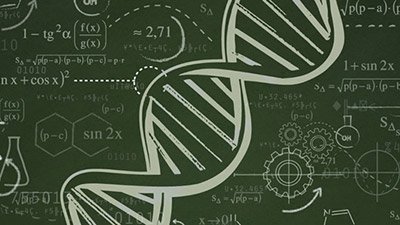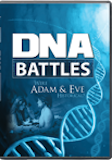
Do Resurrected Proteins Reduce Irreducible Complexity?
Are resurrected proteins the death knell of irreducible complexity?
News Source
- Nature: "Prehistoric proteins: Raising the dead"
The actual Resurrection of Jesus Christ from the dead is proof Jesus is truly the “Son of God with power” (Romans 1:4)—power as Creator (Revelation 4:11), power as Savior (1 John 4:14), and power as the source of reliable “treasures of wisdom and knowledge” (Colossians 2:3). Thus, publicity surrounding Dr. Joe Thornton’s molecular genetics laboratory announcing he has in his freezer “a valuable collection of proteins that had been extinct for hundreds of millions of years until Thornton and his team brought them back from the dead” rings with the power of life and death over intelligent design and, more specifically, belief in biblical creation. A former Greenpeace activist, Thornton—whom we quoted previously in a more technical discussion of his work—“has been fearless — almost enthusiastic — about highlighting the challenge that his work presents to a creationist argument called intelligent design: the claim that complex molecular systems can only have been created by a divine force. Thornton shows how evolution did the job, leaving no need for a designer.”
The idea, he believes, is that an ancestral gene duplicated itself multiple times—a modular construction.
If you picture a modular construction with subsequent random alterations in some of the modules, you’ll have a pretty good grasp of Thornton’s theory. The idea, he believes, is that an ancestral gene duplicated itself multiple times—a modular construction. Then random mutations affected some of the copies. The final resulting protein built from this mutated modular mega-gene is therefore a complex evolutionary product of random destructive mutations. Such molecular time travel presumably proves “Random mutations that actually corrupted proteins . . . led to [what intelligent design proponents call] ‘irreducible complexity.’”
Why is Thornton so confident genetic blueprints for complex proteins evolved just this way? So confident he claims resurrected ancient proteins are in his freezer? How does he resurrect prehistoric proteins?
Most prehistoric proteins emerging from Thornton’s “protein-resurrection toolbox” are steroid receptors. Hormonal steroids are chemical messengers such as estrogen, cortisol, and aldosterone. Steroid molecules have structural similarities and may be synthesized along similar chemical pathways, diverging at critical stages to produce the various steroids. Not surprisingly, therefore, the receptors that detect them have similarities along with key differences to allow the steroid molecules to bind and thus “deliver” their messages.
After comparing steroid receptor proteins in “a slew of living organisms,” Thornton “clambered backwards through the evolutionary tree to deduce the most likely sequence of the common ancestor of all such receptors, which existed some 600 million to 800 million years ago, in the common ancestor of ‘you and a snail,’ as he puts it. Instead of stopping there, as most evolutionary biologists would have done, he then built the gene and inserted it into cells that could manufacture the ancient protein. Resurrecting the protein, says Thornton, allowed his team ‘to experimentally test hypotheses about evolution that would otherwise be just speculation’” (emphasis ours).
Molecular clock dating—a method based on circular reasoning, statistical mismanagement, and unverifiable assumptions—assures Thornton a steroid receptor evolved through gene duplication with subsequent mutations millions of years before a corresponding steroid evolved. Therefore, evolutionists are “sure such studies solidly refute all parts of the intelligent design argument,” as one recently wrote in an article entitled “Reducible Complexity.”
Thornton is helping to put some flesh on the bones of speculation about how complexity arises.
Thornton’s work is garnering praise from fellow evolutionists. Popular evolutionary molecular biologist Kenneth Miller, for instance, says Thornton is “helping to put some flesh on the bones of speculation about how complexity arises.” So what is Thornton doing that no one has done before? “Instead of passively observing things as most evolutionary biologists do,” says evolutionary molecular biologist Antony Dean, if you work in Thornton’s lab “you actively go in and test the hypotheses experimentally.” Thus we see that Miller, Dean, and Thornton are in agreement that reliable scientific conclusions should be observable and testable.
But are his? Or are they yet still just more “speculation”? Common designs—such as biochemical similarities—are consistent with a Common Designer who designed all living things to live in and interact with the same world. Since molecules like steroids do have many similarities and shared biosynthetic pathways, the ability to reverse engineer an “ancestral” steroid receptor to create a functional hypothetical predecessor is a nice bit of biochemistry, but it doesn’t prove that “predecessor” was ancestral to anything. Likewise, determining what DNA structure could produce such a molecule, synthesizing that gene, and allowing cellular machinery to manufacture a protein from it is another nice bit of modern molecular genetics, but it does not demonstrate such a process happened in the past.
Origins science requires the scientist to base interpretations on assumptions about long past events. Those events are not occurring today and therefore cannot be tested scientifically or observed in the present. And even if those processes were occurring in the present, they would not be identical with the ones believed by evolutionists to have “created” the universe we see, since, after all, this universe is already here. Thornton believes his molecular time travel can “break evolution down into detailed steps that he can test” and indicates that which cannot be so tested should not be disguised as science. By his definition, then, though these biochemical processes work, they work in the present and should not disguise themselves as scientific proof about the past.
Far from demonstrating how genetic information evolved, Thornton’s work merely plays games with existing information. Creationist Dr. Georgia Purdom, a molecular geneticist, explains, “Once again we see a ‘just-so’ story of what gene duplication and mutation can supposedly accomplish. What evolutionists need to show are examples of mechanisms that lead to the gain of new genetic information that can lead from molecules to man given enough time. Thornton’s ‘resurrected proteins’ are merely the tweaking of pre-existing genetic information leading to loss of receptor specificity.”
This “resurrection” should not convince anyone of the truth of evolution. Indeed, a person’s worldview determines how convincing a resurrection is. If a person’s worldview is such that he understands observable science is observable only in the present, then these “resurrected prehistoric proteins” are nothing more than a nice biochemical puzzle. God’s eyewitness account in Genesis tells the true story of our origins. Molecular time travel cannot.
In contrast, the Resurrection of Jesus Christ was attested to by many witnesses as He showed Himself alive by “many infallible proofs” (Acts 1:3). Nevertheless, He prophetically explained that those who are determined not to “hear Moses and the prophets [who spoke of the coming Christ (John 5:46-47)], neither will they be persuaded though one rise from the dead” (Luke 16:31). It is for this reason we care that people understand the Bible is trustworthy from the very first verse, for those same books of the Bible explain clearly the reason humanity needed a Savior.
Further Reading
- The End of Irreducible Complexity?
- Is the Intelligent Design Movement Christian?
- A Creationist Perspective of Beneficial Mutations in Bacteria
- The Sequence of Christ’s Post-Resurrection Appearances
- Did the Resurrection Really Happen?
For More Information: Get Answers
Remember, if you see a news story that might merit some attention, let us know about it! (Note: if the story originates from the Associated Press, FOX News, MSNBC, the New York Times, or another major national media outlet, we will most likely have already heard about it.) And thanks to all of our readers who have submitted great news tips to us. If you didn’t catch all the latest News to Know, why not take a look to see what you’ve missed?
(Please note that links will take you directly to the source. Answers in Genesis is not responsible for content on the websites to which we refer. For more information, please see our Privacy Policy.)
Recommended Resources

Answers in Genesis is an apologetics ministry, dedicated to helping Christians defend their faith and proclaim the good news of Jesus Christ.
- Customer Service 800.778.3390
- © 2024 Answers in Genesis





